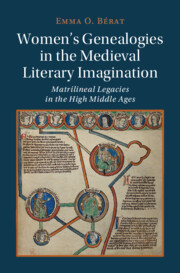 Women's Genealogies in the Medieval Literary Imagination
Women's Genealogies in the Medieval Literary Imagination Violent Transmission in Athelston
Published online by Cambridge University Press: 14 March 2024
Genealogical narratives often include a strand of violence and physical effort for women, particularly through childbirth but also through exile, migration for marriage, and establishing an independent life, as the previous chapters show. This chapter explores genealogical transmission and its relationship to violence and women’s action in the context of administrative communication networks in the Middle English Athelston, in which the king kicks his wife, killing his heir, and sentences his pregnant sister to a trial by fire. Drawing on network theory, which emphasizes the “doers” and “doing” of a network, the chapter explores the alignment of the two royal heir-bearers with messengers, which positions the women as key transmitters, not unlike the Virgin Mary at the Annunciation, rather than as wives who simply carry their husbands’ children. In this model of transmission, the women influence succession not only through childbearing but also through royal petitioning, letter writing, and prayer.
To save this book to your Kindle, first ensure [email protected] is added to your Approved Personal Document E-mail List under your Personal Document Settings on the Manage Your Content and Devices page of your Amazon account. Then enter the ‘name’ part of your Kindle email address below. Find out more about saving to your Kindle.
Note you can select to save to either the @free.kindle.com or @kindle.com variations. ‘@free.kindle.com’ emails are free but can only be saved to your device when it is connected to wi-fi. ‘@kindle.com’ emails can be delivered even when you are not connected to wi-fi, but note that service fees apply.
Find out more about the Kindle Personal Document Service.
To save content items to your account, please confirm that you agree to abide by our usage policies. If this is the first time you use this feature, you will be asked to authorise Cambridge Core to connect with your account. Find out more about saving content to Dropbox.
To save content items to your account, please confirm that you agree to abide by our usage policies. If this is the first time you use this feature, you will be asked to authorise Cambridge Core to connect with your account. Find out more about saving content to Google Drive.